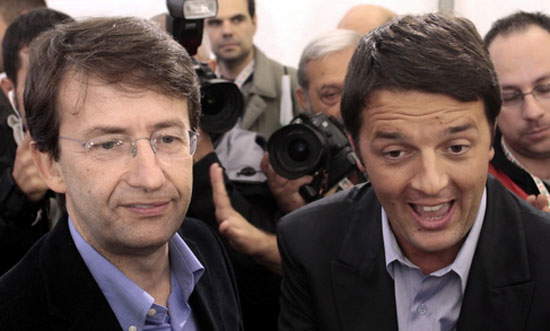“The PD was born to unite, to overcome divisions.” Scanning this statement was the minister of cultural heritage, Dario Franceschini, in an interview published yesterday in Repubblica. The call for unity, somewhat belated, comes in the aftermath of the Dems’ defeat in the last local elections, but above all it comes when the hoped-for unity now takes on the appearance of a chimera rather than that of a real goal to be pursued: the PD, which has never been truly united but which, if anything, has always shown itself to be the shaky sum of a series of more or less small currents held together, especially after the rise of Matteo Renzi, by a leader with a strong political and media impact, has come to identify itself almost totally with the figure of its secretary, and the internal rifts, revealed in all their gravity following the last electoral round, appear to be as irremediable as ever.
 |
| Dario Franceschini and Matteo Renzi. Photo by Formiche.net |
However, narrowing the view to the area of close interest to our newspaper, the claim that the PD was born to unite clashes tremendously with the results achieved by Franceschini’s three-year term at the head of the department in charge of culture, as part of the governing action conducted by the renzian PD. I do not feel like affixing to Dario Franceschini, as has already been done by others, the label of “the worst minister of culture” the country has ever known (let us remember that, only in recent years, we have been able to unhappily taste the passivity of Bondi, the inconsistency of Galan and the immobility of Ornaghi, the trio who, according to Settis, in fifteenth-century Florence “would have buried the Renaissance”), but certainly it is realistic to say that his conduct and even his attitude have chased any purpose except that of overcoming divisions, which, indeed, for the past three years have been terribly exacerbated.
The new museum directors, directly appointed by the minister, have in many cases run their institutions under the sign of a strong decisionism hitherto almost unheard of (think of the National Gallery in Rome, where the museum’s new course has even led to a flurry of resignations in the scientific committee): we have witnessed notable changes of direction, upheavals in museum structures, and results that are, moreover, often comforting (I am thinking, in particular, of the Pinacoteca di Brera, which is reaching very high standards in its displays, communication, and offerings to the public and scholars), but the change in museum leadership has also given rise to a very sharp contrast between the highest spheres of the ministry and the grassroots, which has felt diminished and delegitimized. And the minister did not feel the need to do anything to smooth out the differences.
On the contrary: there was no shortage of occasions for tension. I am thinking, for example, of all the times that workers at museums and archaeological sites have called for union assemblies or strikes. Always in full compliance with the regulations in force, always with notices issued in the timeframe required by law, always keeping the doors of the institutes closed for a few hours. And certainly for shorter durations than those that in many cases were necessary to prepare the fittings of public museum halls designated to accommodate private festivities. The government leadership, however, has always stymied the legitimate grievances of the workers, so much so that it has gone so far as to bring the activity of cultural venues, by a special decree-law consisting of a single article, within the scope of essential public services-a move that has been seen more as an attempt to hinder the workers than as a measure aimed at guaranteeing citizens an efficient and timely service.
And what about the Superintendencies, Renzi’s main nag, which have undergone reckless mergers and paradoxical reorganizations often aimed at countering measures promoted by other members of the council of ministers, such as the one on silence-consent introduced by the Madia law, which provided a glaring example of divisions within the government itself? And how can we not mention the disagreements with new recruits, to whom only a five-hundred-hire competition was proposed, insufficient even to cover turnover, or at most a few calls for precarious jobs, often hidden behind the guise of volunteerism?
The 17th legislature, which is now approaching its final stages, as far as cultural heritage is concerned, will certainly leave behind it some good results, but also a ministry divided as it has probably never been before, with technicians and functionaries who continually complain about the lack of listening on the part of management, with safeguarding now reduced to the bone and left in the hands of superintendencies drastically depleted and now no longer able to carry out capillary actions to garrison their territories, with economic resources scarcely higher than the levels of Bondi’s ministry, with young people coming out of universities who have lost much of their confidence, with a staff with an exaggeratedly high average age that appears tired and unmotivated. Of course: if culture, in recent years, had truly sought that unity to which it is now appealing in view of the upcoming political elections, perhaps we would be telling a different story now.
Warning: the translation into English of the original Italian article was created using automatic tools. We undertake to review all articles, but we do not guarantee the total absence of inaccuracies in the translation due to the program. You can find the original by clicking on the ITA button. If you find any mistake,please contact us.